Social Media Automation: Pros, Cons, and Best Practices
Social media is a staple part of our modern lives. It has revolutionised how we communicate, connect with others, access news and entertainment, and do business. With billions of active users across platforms like Facebook, Instagram, Twitter, LinkedIn, and TikTok – social networks have never been more influential or important.
But let's face it – maintaining an engaging presence across multiple social media channels is incredibly time-consuming. Creating content, scheduling posts, responding to comments and messages, tracking analytics…it can feel like a full-time job. That's where social media automation comes in.
Automation tools and services promise to streamline workflows, boost efficiency, and free up time by handling the repetitive, tedious tasks involved in social media management. However, automating an inherently social activity seems contradictory. What are the potential drawbacks? And what best practices should businesses, brands and individuals follow to get the most benefit from automation without compromising authenticity?
This article will explain the key pros and cons of automating social media efforts. I'll also explore commonly used tools and features, share helpful tips, and provide strategic guidelines for using automation responsibly and effectively.
So grab a coffee, settle in, and dive into the world of social media automation!
Table of Contents
Why Social Media Automation Has Become So Popular

Before examining the advantages and disadvantages, let's look at the factors driving the mass adoption of automation across social platforms. There are several core reasons why scheduling posts, auto-replies, chatbots, analytics tracking, and other automated features have become so widespread:
Saves Precious Time & Effort
Toggling between numerous social accounts, channels, and tools is draining. Not to mention the mental work required to develop creative posts and captions tailored to each network constantly. Scheduling content in advance, automating image/video creation, and delegating engagement tasks frees up headspace and working hours for other priorities.
Helps Stay Consistent and On-Brand
With automation, maintaining a regular, high-quality posting schedule across LinkedIn, Facebook, Instagram, Twitter, etc., is more manageable. Queuing up content in bulk using scheduling tools ensures your audience experiences cohesive branding, consistent messaging, and uninterrupted engagement no matter which channel they follow.
Maximises Impact During Peak Times
Posting at optimal times when your audience is most active is critical for maximising reach, impressions and engagement rates. However, calculating multiple “peak times” for a global audience and remembering to post accordingly on every platform manually is highly impractical. Automation allows you to hit primetime slots without fail, even when you're occupied, asleep, or enjoying offline time.
Enables Personalised, 1:1 Interactions
Chatbots, smart auto-replies, and other conversational automation tools help streamline manual customer engagement. Handling simple, frequently asked questions and repetitive conversations frees up time for brands and influencers to focus on providing rich, authentic experiences to critical fans and followers.
Breaking Down the Key Pros and Cons
Now let's look at the major advantages and disadvantages of incorporating automation into your social media strategy:
The Pros of Social Media Automation
Consistency & Frequency
Posting consistently is crucial for growing and maintaining a social following. However, keeping up a regular cadence of high-quality content takes considerable effort. Social media automation tools allow you to bulk schedule weeks or months' posts in advance. This ensures your profiles look active and avoids dry spells in engagement.
Expanded Reach & Impressions
By scheduling social media posts at multiple strategic times throughout the day, you can extend your content's “shelf life.” Instead of having just a few hours of visibility, your posts stay prominent for longer, continuing to be discovered, interacted with and shared.
Regularly appearing in front of your audience in our fast-paced, crowded social feeds is critical for maximising visibility and impressions.
Reports that consistent posters experience 23% higher engagement rates and 119% more impressions than occasional posters.
Time Savings & Efficiency
Managing a social presence involves endless routine tasks that consume weekly hours – editing images, crafting captions, researching hashtags, scheduling posts, monitoring mentions, analysing metrics, and creating content. Automation can offload many of these tedious processes to focus your time on the core activities that require a human touch.
According to a recent survey, top-performing businesses are leveraging automation and integration tools that streamline processes compared with less successful counterparts.
The Cons of Social Media Automation
Loss of Authenticity
The whole premise of social media relies on human interaction, personalised experiences, and building genuine connections. Overusing auto-generated content, bots and other intensive automation risks coming across as cold, insincere or spammy. This undermines the authenticity and appeal of your presence on social platforms.
Missed Engagement Windows
While scheduling posts ensures a consistent, optimised flow of content, there's a risk of missing out on opportunities for real-time engagement. Trends, breaking news, and viral memes often have a short shelf-life. Automating 100% of your social content could cause you to miss out on engaging in timely conversations when they're happening.
Limited Context & Nuance
There's only so much you can automate without losing context, nuance or personalisation. Pre-scheduling:
- Responses to comments
- Replies to messages
- Participation in trending hashtag discussions
Misses opportunities to provide thoughtful, contextual answers that satisfy your audience's questions, needs and sentiments.
Risk of Mistakes Multiplying
When using automation, a single typo, incorrect image or broken hyperlink will immediately multiply across multiple scheduled posts. Double and triple-check scheduled content to avoid embarrassing or reputation-damaging errors snowballing out of control before you can pause your queued posts.
30 Best Social Media Automation Tools and Features
Okay, now that we've looked at some key pros and cons, let's review seven leading social media automation tools and popular features that can streamline and amplify your efforts:
Post Scheduling & Queuing
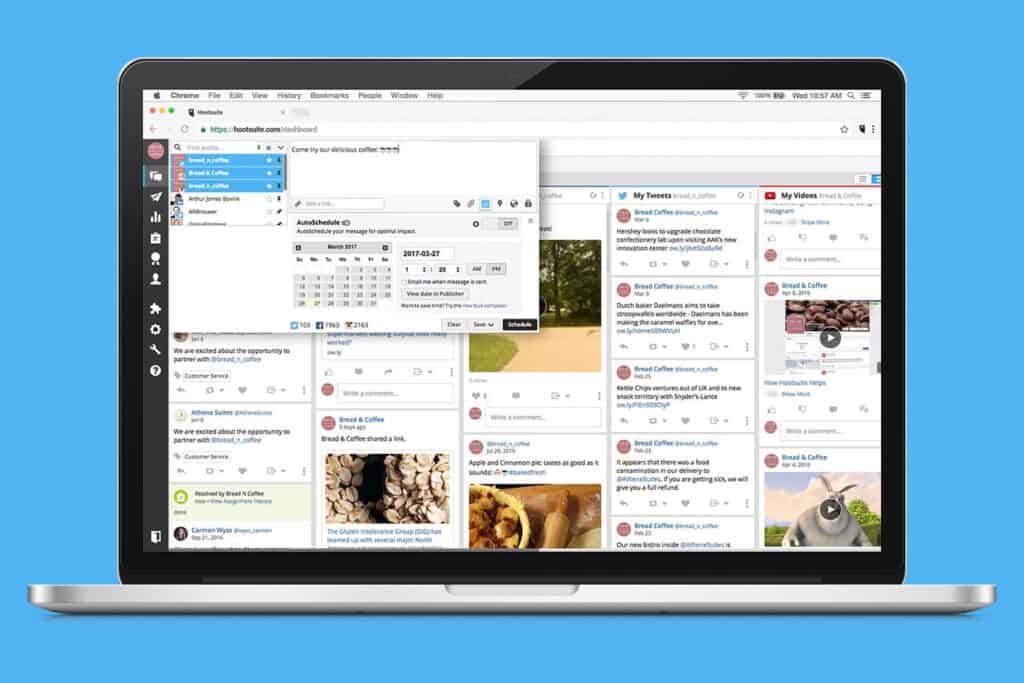
This is the first feature that comes to mind when considering social media automation.
- Hootsuite is a popular social media management platform that allows users to schedule posts across multiple social media platforms such as Facebook, Twitter, Instagram, and LinkedIn. It offers a user-friendly interface for scheduling posts in advance, managing content calendars, and monitoring social media activity. Hootsuite's scheduling feature enables users to plan and organise their content strategy efficiently, ensuring consistent posting and engagement with their audience.
- Buffer is another widely-used social media management tool that simplifies the process of scheduling and queuing posts. With Buffer, users can schedule posts for multiple social media accounts and platforms, including Twitter, Facebook, LinkedIn, Instagram, and Pinterest. It offers a clean and intuitive interface, making it easy to create and schedule posts and analyse engagement metrics to optimise posting times and content strategy.
- Sprout Social is a comprehensive social media management platform with post-scheduling and queuing features and other capabilities such as social listening and analytics. Users can schedule posts across social media networks, collaborate with team members, and monitor engagement from a single dashboard. Sprout Social's scheduling functionality allows for efficient content planning and distribution, helping businesses maintain a consistent presence on social media.
- Later is a popular visual content scheduling tool specifically designed for Instagram, although it also supports scheduling for other platforms like Facebook, Twitter, and Pinterest. It offers features such as a visual content calendar, a drag-and-drop interface for scheduling posts, and previewing Instagram posts before they go live. Later's focus on visual content makes it particularly useful for brands and influencers looking to maintain a curated and cohesive Instagram feed.
- CoSchedule is a versatile marketing calendar and social media scheduling tool that helps users plan, organise, and schedule content across multiple channels. It offers features like customisable marketing calendars, social media automation, and integrations with popular platforms like WordPress and Google Analytics. CoSchedule's collaborative features make it suitable for teams working on content creation and distribution, streamlining the process of scheduling and queuing posts for maximum impact.
- Sendible is a social media management platform tailored for agencies and businesses to manage their online presence efficiently. It offers advanced scheduling capabilities, including queueing posts, creating content calendars, and scheduling posts across various social media networks. Sendible also provides powerful analytics and reporting tools, allowing users to track the performance of their social media campaigns and adjust their strategy accordingly.
- MeetEdgar is a unique social media scheduling tool focusing on evergreen content recycling. It allows users to create a library of reusable content, which can be automatically reposted at scheduled intervals, helping maximise their posts' lifespan and reach. MeetEdgar's automation features save time and effort by ensuring a steady content stream without constant manual scheduling.
All leading scheduling tools like Hootsuite, Sprout Social, Buffer, and Later allow you to:
- Plan a content calendar and upload posts in bulk
- Schedule exact delivery dates/times across multiple platforms
- Queue up an unlimited stream of Evergreen content, rotating continuously
- Upload and optimise images/videos with built-in editing tools
- Tag relevant accounts to increase discoverability
- Deploy posts with a single click or on auto-pilot
Most also offer recommended posting times, hashtag suggestions, and integrations with digital asset libraries, URL shorteners, and recycling tools to streamline processes further.
Automated Image & Video Creation
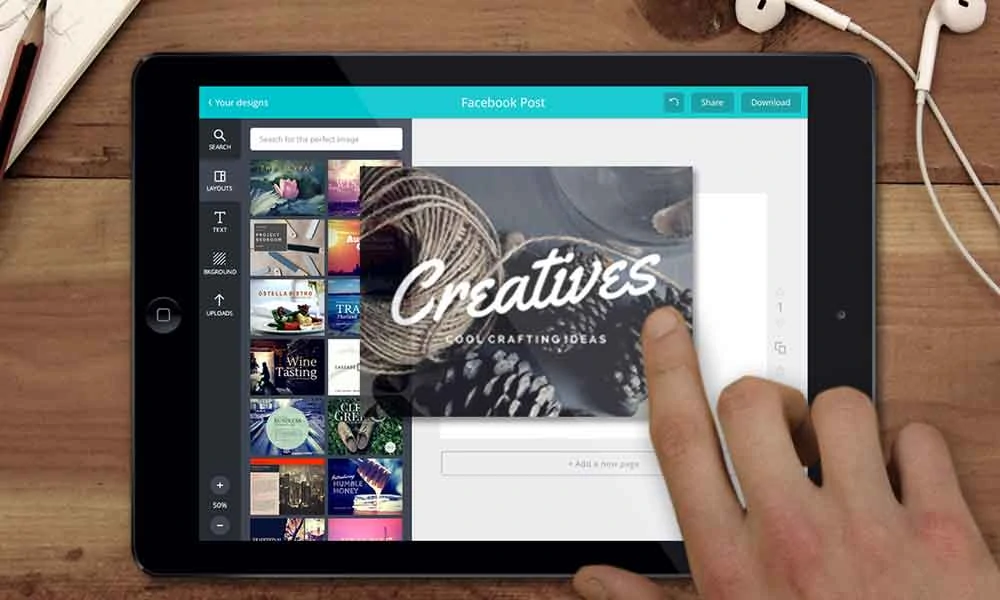
Automating repetitive editing and enhancing tasks is a massive time-saver for brands and influencers, creating a ton of visual content.
- Canva is a versatile graphic design tool that offers a range of templates and design elements for creating images and videos. It allows users to easily customise designs with drag-and-drop functionality, making it accessible for users with varying levels of design expertise. The canvas library includes millions of stock photos, illustrations, icons, and fonts, enabling users to create visually appealing content for social media platforms quickly.
- Adobe Express is a user-friendly design tool that simplifies creating graphics, web pages, and videos. It offers professionally designed templates and easy-to-use editing features, allowing users to customise their content with text, images, and animations. The integration with Adobe Creative Cloud enables seamless collaboration and access to additional design assets, enhancing the quality and creativity of social media content.
- Animoto is a video creation platform that produces high-quality videos from photos, video clips, and music. It offers customisable templates and themes and intuitive editing tools for adding text, transitions, and effects. Animoto's intelligent technology automatically arranges content to create engaging video stories, making it ideal for sharing dynamic visual content on social media platforms.
- Lumen5 is an AI-powered video creation platform that transforms text-based content into engaging videos. It uses machine learning algorithms to analyse text and select relevant visuals, animations, and music to accompany the narrative. Lumen5's intuitive interface and automated features streamline the video creation process, enabling users to produce professional-looking videos for social media marketing campaigns in minutes.
- Promo is a video creation platform specialising in producing short promotional videos for social media advertising. It offers a vast library of stock footage, music tracks, and pre-designed templates tailored for different industries and marketing objectives. Promo's user-friendly interface and automated editing tools simplify the video creation, allowing users to customise content with their branding elements and messaging effortlessly.
- Biteable is a cloud-based video maker that offers a wide range of customisable templates for creating animated videos, presentations, and ads. It provides access to a vast library of animations, footage, and music tracks, enabling users to create engaging visual content for social media platforms. Biteable's drag-and-drop editor and real-time preview feature make experimenting with different styles and elements easy, empowering users to produce professional-grade videos quickly.
- Wave.video is a comprehensive video marketing platform that offers tools for creating, editing, and sharing videos on social media. It provides a library of customisable templates, stock videos, royalty-free music tracks, and advanced editing features like text overlay, transitions, and colour correction. Wave.video's collaboration tools and multi-platform publishing capabilities streamline the video creation and distribution process, helping businesses maximise their reach and engagement on social media channels.
Tools like Canva, Crello, Vista Create and Adobe's Express suite enable you to template designs and automate tasks like:
- Resizing social images/videos for different platforms
- Adding branding overlays, logos, filters and text-based graphics
- Cropping, colour grading, enhancing lighting and overall visual polish
- Auto-generating dozens of fresh visual assets with a few clicks
Social Listening & Analytics Tracking
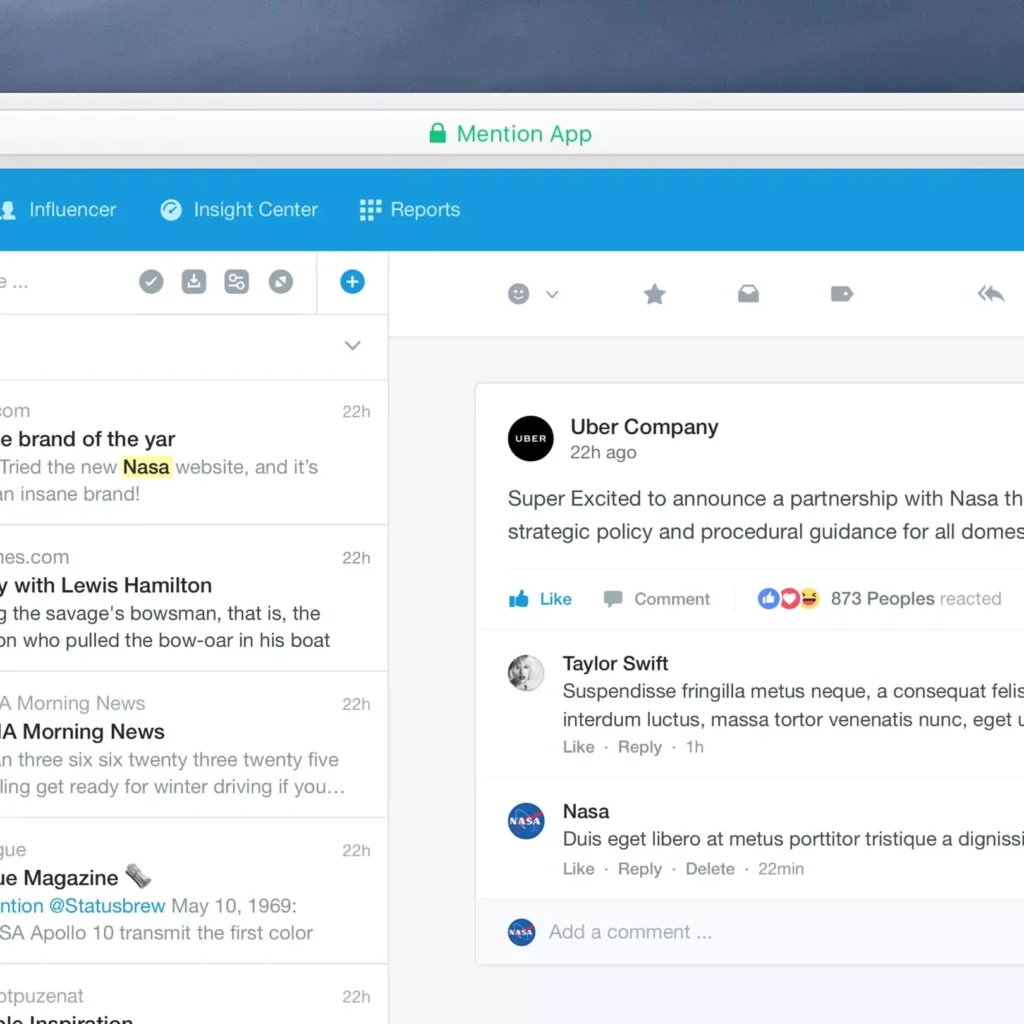
Tracking social media analytics can give you meaningful insights into your top-performing content, engagement rates, ideal posting times, audience demographics and more. But manually compiling performance metrics across different platforms is crazy time-consuming.
- Brandwatch is a powerful social listening and analytics tool that enables businesses to monitor online conversations and track brand mentions, sentiment, and trends across various social media platforms and online channels. It provides advanced analytics and customisable dashboards to visualise data and gain insights into audience demographics, influencers, and competitive intelligence. Brandwatch helps businesses make data-driven decisions and optimise their social media strategies.
- Talkwalker is an AI-powered social listening and analytics platform that provides real-time insights into online conversations and brand mentions across social media, news websites, blogs, forums, and more. It offers sentiment analysis, competitive benchmarking, and influencer identification features to help businesses understand consumer sentiment, track industry trends, and identify opportunities. Talkwalker's customisable dashboards and reports enable enterprises to monitor their brand reputation and measure the impact of their social media campaigns.
- Mention is a monitoring tool that helps businesses track brand mentions, keywords, and hashtags across social media platforms, news sites, blogs, and forums. It provides real-time alerts, sentiment analysis, and competitive analysis features to help businesses stay informed about relevant conversations and trends. Mention also offers reporting capabilities to measure social media performance and ROI, allowing companies to optimise their marketing strategies and improve brand reputation.
- Awario is a social media monitoring and analytics tool that enables businesses to track brand mentions, keywords, and trends across social media platforms, news websites, blogs, and forums. It offers sentiment analysis, influencer identification, and competitive analysis features to help businesses understand consumer sentiment, identify key influencers, and monitor competitor activity. Awario's customisable dashboards and reports provide actionable insights to inform marketing strategies and improve brand perception.
- Sysomos is a social listening and analytics platform that helps businesses monitor conversations, track brand sentiment, and analyse social media data to gain valuable insights into audience behaviour and preferences. It offers real-time monitoring, sentiment analysis, and competitive intelligence features to help businesses understand the impact of their social media efforts and identify opportunities for engagement and growth. Sysomos provides customisable dashboards and reports to track key metrics and measure the success of social media campaigns.
Feed analytics straight into your central dashboard using tools like HubSpot, Sprout Social, Keyhole, and Hootsuite to track performance over time automatically.
For brands launching influencer campaigns, apps like InfluenceGrid can automate aggregating sponsored content links, stats, and UTM links into simple reporting templates.
AI-Assisted Content Creation
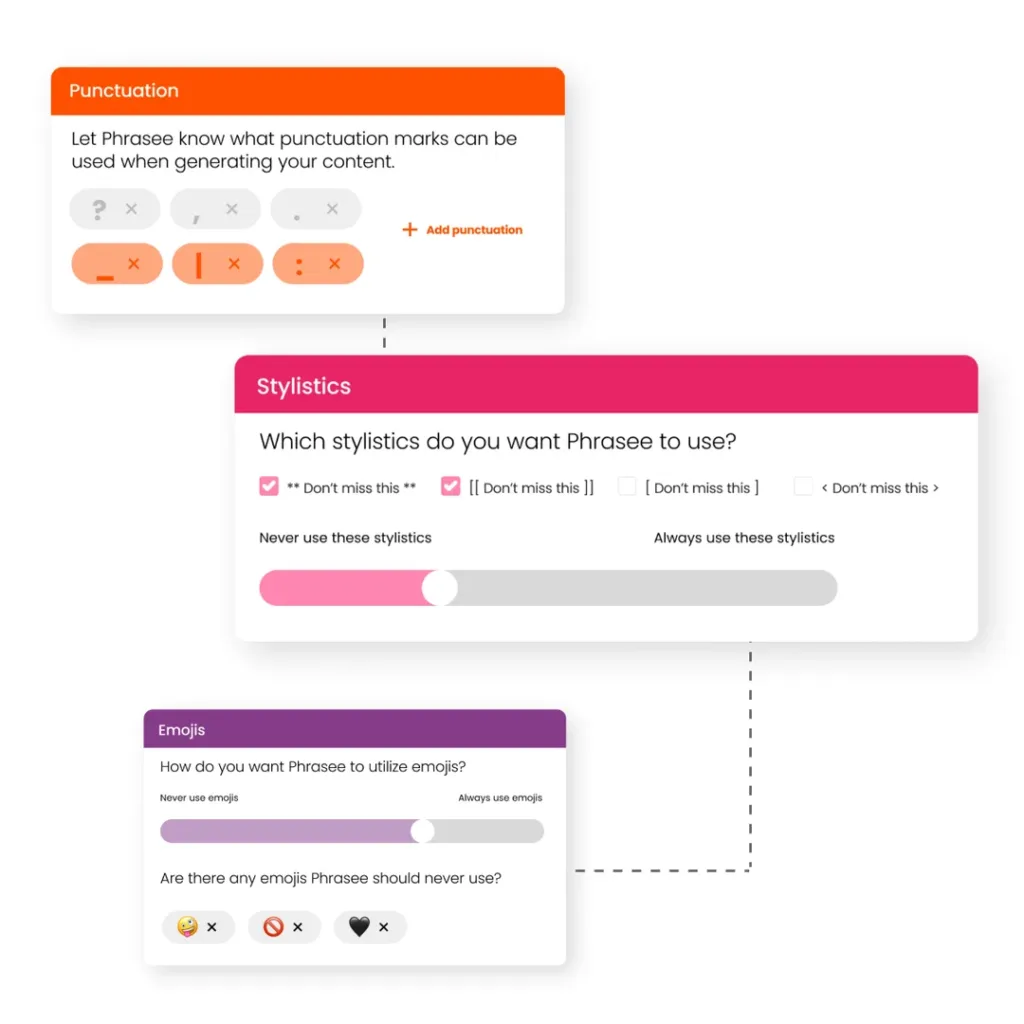
AI image generators like DALL-E, Midjourney, StableDiffusion and ChatGPT are revolutionising the content creation by automatically producing polished, on-brand media based on text prompts.
While you'll want to avoid Overusing AI-generated visuals across your social channels (it can feel inauthentic), these tools can be convenient for quickly creating supporting assets like brand templates, background images and props to help your brand message.
- Phrasee: Phrasee is an AI-powered copywriting tool designed specifically for marketing. It uses natural language processing (NLP) and machine learning algorithms to generate compelling email subject lines, social media posts, and ad copy. Phrasee analyses data from past campaigns to suggest language that resonates with the target audience, leading to higher engagement and conversion rates.
- Hootsuite Insights: Hootsuite Insights is an AI-powered social listening tool that enables marketers to monitor conversations and trends across various social media platforms. By analysing vast amounts of social data in real-time, Hootsuite Insights provides valuable insights into audience preferences, sentiment, and behaviour. Marketers can use this information to tailor their content strategies, engage with their audience more effectively, and identify growth opportunities.
- HubSpot Social Inbox: HubSpot Social Inbox is an AI-driven social media management tool that helps marketers organise, schedule, and analyse their social media content. It uses machine learning algorithms to categorise and prioritise social media interactions, allowing users to focus on engaging with the most relevant conversations and leads. HubSpot Social Inbox also provides insights into audience engagement metrics and suggests personalised content recommendations based on user preferences.
- RecurPost: RecurPost is a social media scheduling and automation tool that employs AI algorithms to optimise content distribution and engagement. It analyses audience behaviour and engagement patterns to determine the best times to post content on various social media platforms. RecurPost also offers content recycling features, allowing users to repurpose evergreen content and maximise its reach over time. With its AI-driven scheduling capabilities, RecurPost helps marketers maintain a consistent presence on social media and drive meaningful interactions with their audience.
Chatbots & Auto Responders
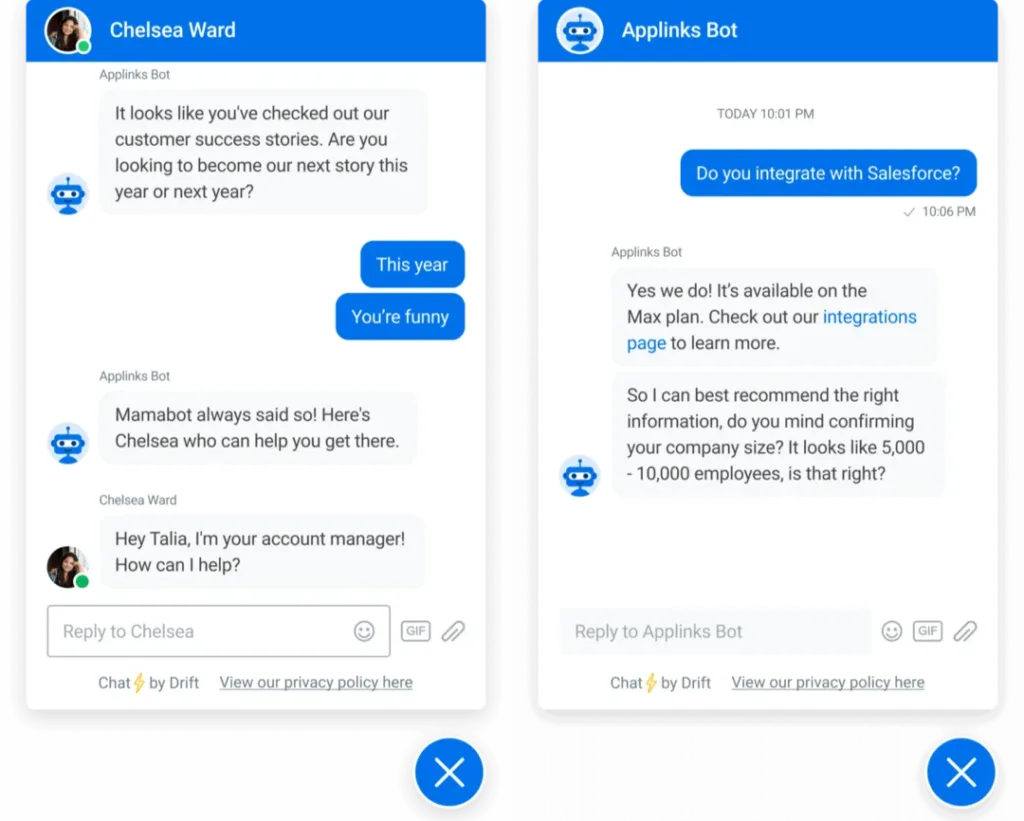
Chatbots and automated messaging features in Instagram, Facebook Messenger, WhatsApp and other DM tools can ease the strain of manually responding to every comment and query. Set up custom autoresponders to:
- Greet new visitors, letting them know when they can expect a human reply
- Provide quick answers to simple, repetitive questions
- Send saved replies with information like opening hours, website URLs, booking details, etc.
- Funnel-specific question types to relevant departments/specialists
Just be sure the inevitable flaws in chatbots don't undermine the quality of customer experience. Have a plan for escalating conversations needing human problem-solving skills.
- Chatfuel: Chatfuel is a popular platform for creating chatbots on Facebook Messenger. It offers a user-friendly interface with drag-and-drop functionality, allowing users to build sophisticated chatbots without any coding knowledge. Chatfuel can help businesses automate customer service, lead generation, and marketing campaigns on Facebook Messenger, thus enhancing engagement and streamlining customer communication.
- ManyChat: ManyChat is another leading chatbot platform designed for Facebook Messenger marketing. It offers features such as visual flow builders, audience segmentation, and integration with other marketing tools. ManyChat helps businesses engage with their audience at scale, deliver personalised messages, and drive conversions through automated conversations on Messenger.
- MobileMonkey: MobileMonkey is a versatile chatbot platform that supports multiple messaging channels, including Facebook Messenger, SMS, and web chat. It offers powerful automation features like chat blasts, drip campaigns, and AI-powered responses. MobileMonkey can help businesses automate lead generation, customer support, and marketing efforts across various channels, improving efficiency and driving results.
- HubSpot: HubSpot offers a suite of marketing, sales, and customer service tools, including a chatbot builder. HubSpot's chatbot can be integrated with its CRM platform, allowing businesses to capture leads, qualify prospects, and provide personalised support. HubSpot's chatbot helps companies automate lead nurturing, sales follow-ups, and customer interactions, enabling them to deliver a seamless and engaging experience across multiple touchpoints.
- Drift: Drift is a conversational marketing platform specialising in real-time messaging and chatbots. It offers AI-powered chatbots, live chat, and account-based marketing tools. Drift's chatbots can engage website visitors' qualified leads and route conversations to the appropriate sales or support team members. Drift helps businesses drive more qualified leads, accelerate sales cycles, and improve customer satisfaction through personalised discussions.
- Zendesk Chat (formerly Zopim): Zendesk Chat is a live chat software with chatbot functionality for automating customer support. It offers automated greetings, chat routing, and chat histories. Zendesk Chat's chatbots can handle frequently asked questions, assist customers with basic inquiries, and escalate complex issues to human agents when necessary. Zendesk Chat helps businesses provide fast and efficient customer support, increasing customer satisfaction and retention.
- Intercom: Intercom is a customer messaging platform that enables businesses to communicate with customers across various channels, including chat, email, and social media. It offers chatbot capabilities for automating customer interactions, capturing leads, and providing personalised support. Intercom's chatbots can qualify leads, schedule appointments, and deliver targeted messages based on user behaviour. Intercom helps businesses build stronger customer relationships by providing timely and relevant communications throughout the customer journey.
10 Tips for Automating Social Responsibly

Now, let's dig into some essential tips and best practices for leveraging automation tools to save time and hassle without compromising authenticity or forgetting the “social” in social media.
Automate Admin Tasks, Not Relationships
Social platforms are for building human relationships. While automation can help ease tedious administrative burdens, don't use it as an excuse to avoid having genuine, personal exchanges with your audience. Respond meaningfully to comments, spark engaging conversations, and connect on a human level.
Keep a Human Voice
When crafting automated posts, auto-responses and chatbot flows, be sure the texts maintain a friendly, natural and characterful human voice. Avoid stiff corporate tones, jargon, or overly salesy language. Keep it light, natural and conversational.
Always Check Your Scheduled Posts
Before pressing that “auto-publish” button, check your scheduled posts thoroughly. Proofread all text, double-check media uploads are correct, and consider any events or news that may call for tweaking messaging. You don't want an insensitive or tone-deaf post-auto-publishing at the worst possible time.
Mix Up Automated and Human-led Content
Aim for a blend of pre-planned, automated posts and spontaneous, in-the-moment shares. Mixing it up keeps your presence feeling dynamic and natural rather than 100% automated. Jump into trending hashtag conversations. Reply directly to comments. Engage with community questions and feedback.
Use Scheduling for Efficiency, Not Full Autopilot
Use content scheduling to eliminate logging in daily and posting haphazardly. But don't just set and forget an entire social media calendar on autopilot. Leave room for adjustments, spontaneity and capitalising on real-time opportunities that might arise.
Create Original, Unique Content
Don't rely too heavily on automation tools that curate and repackage content from RSS feeds, Reddit threads, Twitter lists, etc. Audiences will quickly lose interest if you're just re-sharing what everyone else is talking about in a lifeless, automated way.
Allocate Time for Being Present and Participatory
Pace yourself to avoid burnout or let social media management consume your free time. Make space in your schedule to show up, observe, listen and join conversations across platforms. Social presence requires regular participation and availability beyond just passive posting.
Test, Learn, Repeat
With any automation workflows, start small and test rigorously. Monitor results, analyse performance and fine-tune processes before ramping up. You'll likely need to tweak posting cadences, language, content formats and more to find the ideal blend of automation and human touch for your audience.
Set Clear Roles, Responsibilities & Rules
If multiple team members have access to social media scheduling tools, lay out clear guidelines around the following:
- Who posts/publishes when
- Preferred creator workflow
- Quality control – post-approval processes
- Crisis response plans
This helps avoid embarrassing mistakes, contradictory messaging, or stepping on each other's toes.
Keep Learning and Stay Curious
Social media and its possibilities are constantly evolving. Keep up-to-date with the latest features, test out new AI tools, watch content trends and brainstorm innovative ways to use automation capabilities in service of your core objectives. Stay curious, and your efforts will always feel fresh and organic!
FAQs on Social Media Automation
What are the most popular social media automation tools?
Leading tools for scheduling posts, analytics tracking, chatbots, and overall social media management include Hootsuite, Buffer, Sprout Social, Sendible, Loomly, HubSpot, and Falcon.io.
What kind of tasks can be automated on social media?
Standard automation processes include bulk content scheduling, queuing Evergreen posts, auto-generated visuals, analytics reporting, social listening, automated messaging responses, and comment filtering.
Is social media automation considered unethical?
Automation can enhance efficiency and extend your reach. But avoid over-reliance, as this can eliminate the human element audiences expect on social channels. Follow best practices for maintaining an authentic social presence to build stronger customer relationships.
How often should I post automated versus spontaneous content?
For most brands and creators, aim for a blend of scheduled content and real-time, human-led posting. Keep some flexibility for joining conversations, reacting to memes/trends, and engaging now.
What are the risks of heavy social media automation?
Going too heavy on automation risks comes across as robotic, inauthentic and impersonal, damaging audience trust and brand appeal. Automation mistakes also tend to multiply before they can be caught.
